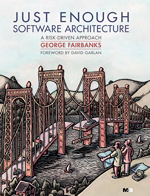Rebecca Wirfs-Brock on Agile Design and Architecture
InfoQ has a nice interview with Rebecca Wirfs-Brock on agile and architecture. From the interview, it is clear she is not a 100% emergent-design proponent, yet she has helpful advice on how design/architecture can fit into agile processes.
Here are some architecture-related quotes of interest:
“My words of advice about people who want to think about emergent design is that it is not a replacement for design thinking at the most responsible time, so there is still places at it that you might need to take things and put them aside and think about it and try alternatives.”
“Well some people might say that if you are, for example, doing test first development that design happens between the keystrokes as you are planning the next test to write. That’s where it happens, right there. But I take a little bit different view in that I think that there are certain rhythms to design, when I am doing something new I may want to do some design thinking, hit the pause button on writing the test and thinking about structuring stuff that could have me explore some alternatives before I turn to the code. That code is the easy part, so I think there is a role for design and architecture and there are different rhythms for when you do it on Agile projects. ”
“… a very simple technique of forming a team is sitting down and after they have been presented [a few hundred story cards], instead of just going into the planning game, to sit the developers of the team write where they think are the easy bits the design challenges, write for ten minutes and then share their stories amongst each other…”
“On projects that have significant amounts of architecture decisions in an Agile world it’s not always that architecture emerges one story card at a time. I think that the most responsible moment might be taking aside and figuring out some of the hard bits just like the user experience folks these days, user experience designers, are recognizing that there is a cycle of discovery and confirmation and then there is this more regular cycle of doing and filling out of the details once you figured it out. Some of those things need to be done in a side band from the regular beat of all the rhythms of an iterative sprint if you will.”



